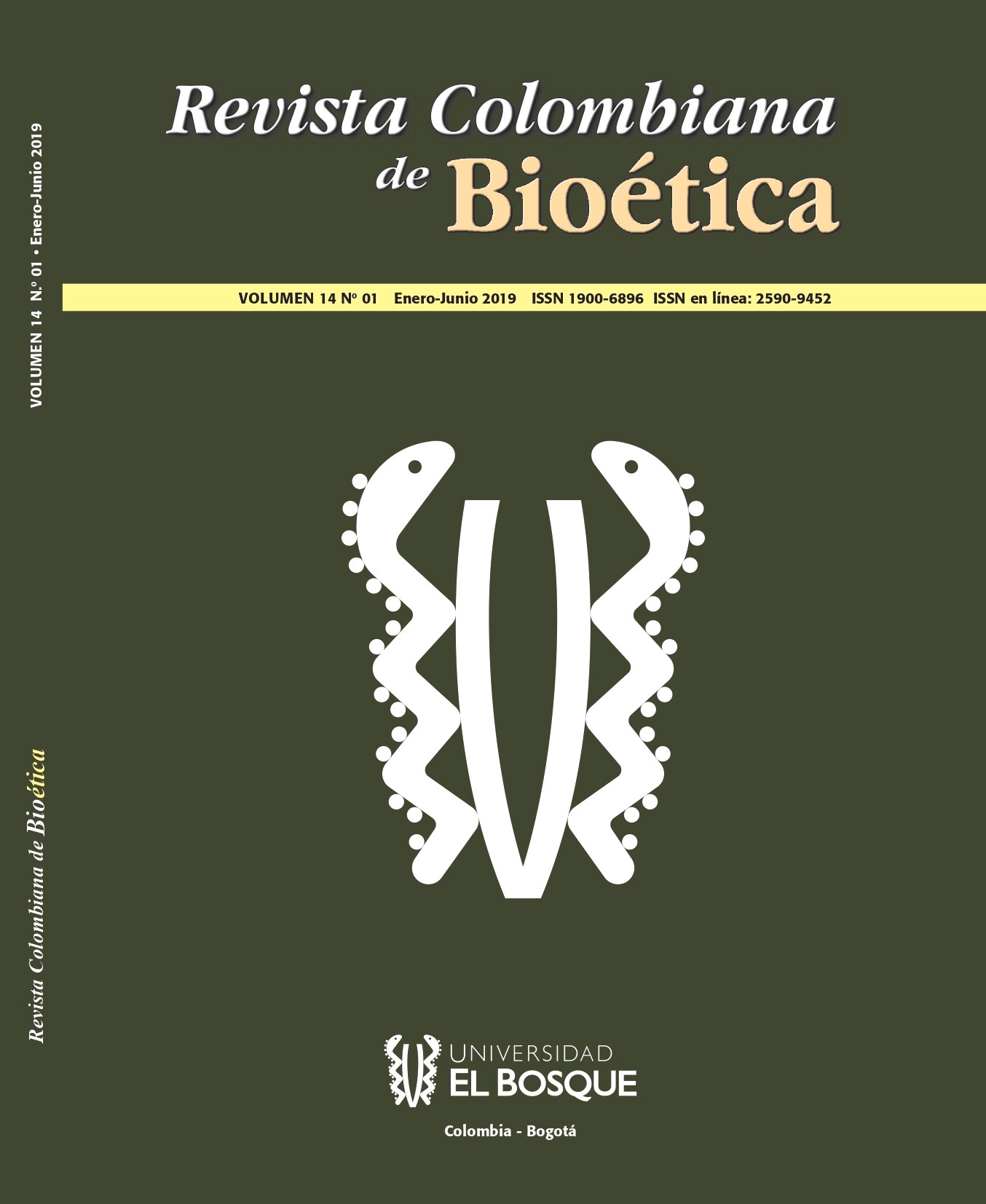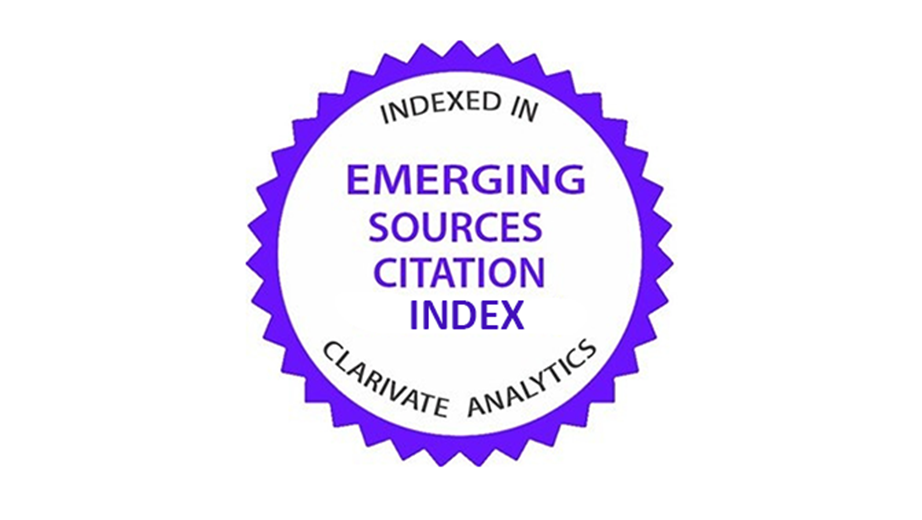Los Comités de Ética en Investigación y la Protección de los Sujetos que Participan en Ensayos Clínicos
DOI:
https://doi.org/10.18270/rcb.v14i1.2430Palabras clave:
Ensayos Clínicos, Comités de Ética, Desempeño.Resumen
Introducción: La responsabilidad por proteger a los seres humanos que participan en investigación ha sido delegada a los Comités de Ética de Investigación. La industria y los investigadores consideran que los CEI retrasan innecesariamente el inicio de la investigación y los bioeticistas dicen que no tienen los recursos para realizar sus funciones. El objetivo de este artículo es identificar las carencias y problemas que afectan el desempeño de los CEI que aprueban protocolos de ensayos clínicos financiados por la industria y las soluciones propuestas.
Métodos: Revisión de la literatura que describe las características de los CEI ubicados en países de altos ingresos que revisan ensayos clínicos financiados por la industria, su desempeño y las sugerencias de fortalecimiento.
Resultados: Los problemas que afectan el funcionamiento de los CEI se conocen desde finales del siglo pasado, tanto entidades reguladoras como investigadores han propuesto formas de fortalecerlos, pero solo unas pocas se han intentado y ninguna se ha institucionalizado. Llama la atención que todavía no haya estándares de formación mínima para los miembros de los CEI, ni se les haya dotado de recursos para monitorear adecuadamente la implementación de los ensayos.
Conclusiones: La necesidad de profesionalizar los CEI beneficia a la industria. Los CEI, al revisar protocolos y monitorear la implementación de los ensayos clínicos y hablar con los sujetos, pueden detectar comportamientos que afectan la calidad de la información recabada y la seguridad de los voluntarios.
Descargas
Referencias bibliográficas
ABBOTT, L; GRADY, C. (2011). A systematic review of empirical literature evaluating IRBs: What we know and what we still need to learn. Journal of Empirical Research on Human Research Ethics, 6 (1):3-19.
AEMPS. (2016). Nueva regulación de los ensayos clínicos Agencia Española de Medicamentos y Productos Sanitarios (AEMPS) Nota de Prensa, 27 de enero de 2016 http://www.saludyfarmacos.org/boletin-farmacos/boletines/feb201604/702_regulacio
ANGELL, M. (2000). Is academic medicine for sale? New England Journal of Medicine, 342:1516-8l.
ASHCROFT, RE. (2005). Commentary: Ethics Committees and countries in transition: a figleaf for structural violence. British Medical Journal, 331:229-230.
ASSOCIATION OF AMERICAN MEDICAL COLLEGES TASK FORCE ON FINANCIAL CONFLICTS OF INTEREST IN CLINICAL RESEARCH. (2002) Protecting subjects, preserving trust, promoting progress II: principles and recommendations for oversight of an institutions’ financial interests in human subjects research. Washington DC: Association of Medical Colleges.
BRAMSTEDT, KA; KASSIMATIS, K. (2004). A study of warning letters issued to institutional review boards in the United States Food and Drug Administration. Clinical and Investigative Medicine, 27(6):316-23.
CAIROLI, E; DAVIES, HT; HELM, J et al. (2012). A syllabus for research ethics committees: training needs and resources in different European countries. Journal of Medical Ethics, 38:184–186.
CHRISTIAN, MC; GOLDBERG, JL; KILLEN J, et al. (2002). A central institutional review board for multinational trials. New England Journal of Medicine, 346: 1405-08.
COLEMAN, CH; BOUESSEAU, MC. (2008). How do we know that research ethics committees are really working? The neglected role of outcomes assessment in research ethics review. BMC Medical Ethics, 9(6) https://doi.org/10.1186/1472-6939-9-6
https://bmcmedethics.biomedcentral.com/articles/10.1186/1472-6939-9-6
DAVIS, JM. (2007). Federally regulated institutional review boards: the aspects of a “model” IRB- is the current system in need of a tune up or complete overhaul? Thesis. The University of Texas, School of Public Health. December.
DE VRIES, RG; FORSBERG CP. (2002). What do IRBs look like? What kind of support do they receive? Accountability in Research Policies and Quality Assurance, 9 (3/4):199-216.
DEN BOER, A; SCHIPPER, I. (2013). New EU regulation on clinical trials: the impact on ethics and safeguards for participants. Indian Journal of Medical Ethics, 10 (2):106-109.
DEPARTMENT OF HEALTH AND HUMAN SERVICES (DHHS). (1998). Institutional Review Boards: A Time for Reform. Washington: DHHS.
DEPARTMENT OF HEALTH AND HUMAN SERVICES (DHHS). (2001). Draft interim guidance: financial relationships in clinical research: issues for institutions, clinical investigators, and IRBs to consider when dealing with issues of financial interests and human subjects protection. Washington: DHHS.
DZIAK, K; ANDERSON, R; SEVICK, MA et al. (2005). Variations among Institutional Review Board reviews in a multisite health services research study. Health Services Research, 40 (1):279-290.
EDWARDS, S; KIRCHIN, S; HUXTABLE, R. (2004). Research ethics committees and paternalism. Journal of Medical Ethics, 30:88-91.
FEDERMAN, D; HANNA, K; RODRIGUEZ, L (Editores). (2002). Responsible conduct of research: A systems approach. Washington DC: Institute of Medicine.
FELDMAN, JA; REBHOLZ, CM. (2009). Anonymous self-evaluation of performance by ethics board members: a pilot study. Journal of Empirical Research on Human Research Ethics 4, 1, 63-9.
FLEISCHMAN, AR. (2005). Regulating research with human subjects: is the system broken? Transactions of the American Clinical and Climatological Association, 116:91-102.
FOST, N; LEVINE, RJ. (2007). The dysregulation of human subjects research. Journal of the American Medical Association, 298 (18): 2196-98.
FREITAS, CBD; SCHLEMPER, BR. (2014). Progress and challenges of clinical research with New Medicines in Brazil. En N Homedes, A Ugalde (editores). Clinical Trials in Latin America: When Ethics and Business Clash. (pp 151-171). Springer (Netherlands).
GAFENAS, E; DRANSEIKA, V; CEKANAUSKAITE, A, et al. (2010). Non-equivalent stringency of ethical review in the Baltic States: A sign of a systemic problem in Europe? Journal of Medical Ethics, 36(7):435-439.
GOLDNER, JA. (2002). Dealing with conflict of interest in biomedical research: IRB oversight as the next best solution to the abolitionist approach. Journal of Law, Medicine, and Ethics, 28:379-404.
GRADY, C. (2010). Do IRBs protect human research subjects? Journal of the American Medical Association, 304 (10):1122-3.
GREENE, SM; GEIGER, AM. (2006). A review finds that multicenter studies face substantial challenges, but strategies exist to achieve Institutional Review Board approval. Journal of Clinical Epidemiology, 59 (8):784-790.
HALL, MA; WEINFURT, KP; LAWLOR, JS et al. Community hospital oversight of clinical investigators’ financial relationships. IRB: Ethics and Human Research 2009; 31 (1):7-13.
HEIMER, CA; PETTI, J. (2010). Bureaucratic ethics: IRBs and the legal regulation of human subjects research. Annual Review of Law and Social Science, 6:601-626.
HELFAND, BT; MONGIU, AK; ROCHRBORN, CG et al. (2009). Variation in Institutional Review Board responses to a standard protocol for a multicenter randomized, controlled surgical trial. The Journal of Urology, 181:2674-79.
HIRSHON, JM; KRUGMAN, SD; WITTING, MD et al. (2002). Variability in Institutional Review Board assessment of minimal-risk research. Academic Emergency Medicine, 9 (12):1417-20.
HOFFMAN, S. (2001). Continued concern: human subject protection. The Institutional Review Board and Continuing Review. Tennessee Law Review, 725:754-55.
HOMEDESS N; UGALDE, A. (2014). Seeking help to confirm a decision: A case study of an Argentinean research ethics committee. Journal of Medical Ethics. 41 (6). http://dx.doi.org/10.1136/medethics-2013-101381
HOMEDES, N; UGALDE, A. (2016). Health and Ethical Consequences of Outsourcing Pivotal Clinical Trials to Latin America: A Cross-Sectional, Descriptive Study. PLoS ONE, 11(6): e0157756. doi:10.1371/journal.pone.0157756 http://journals.plos.org/plosone/article?id=10.1371/journal.pone.0157756
HOMEDES, N; UGALDE, A. (2016b). Ensayos clínicos en América Latina: implicancias para la sustentabilidad y seguridad de los mercados farmacéuticos y el bienestar de los sujetos). Salud Colectiva, 12(3) http://revistas.unla.edu.ar/saludcolectiva/article/view/1073/1040
IOANNIDIS, JPA. (2016). Why most clinical research is not useful. PLoS Medicine, 13(6): e1002049 http://journals.plos.org/plosmedicine/article?id=10.1371/journal.pmed.1002049 Traducido por Salud y Fármacos, y disponible en: http://www.saludyfarmacos.org/boletin-farmacos/boletines/sep201604/003_mayoria/
JANSEN, LA. (2005). Local IRBs, multicenter trials and the ethics of internal amendments. IRB: Ethics and Human Research,10:7-11.
KAPLAN, S. (2016). In clinical trials, for-profit review boards are taking over for hospitals. Should they? Statnews, 6 de julio https://www.statnews.com/2016/07/06/institutional-review-boards-commercial-irbs/ Traducido por Salud y Fármacos y disponible en http://www.saludyfarmacos.org/boletin-farmacos/boletines/sep201604/037_eeuu/
KLITZMAN, R. (2013). How good does the science have to be in proposals submitted to Institutional Review Boards? An interview study of institutional review board personnel. Clinical Trials, 10:761-766.
KLITZMAN, R. (2013b). How IRB leaders view and approach challenges raised by industry-funded research. IRB: Ethics and human research, 35(3):9-17.
KLITZMAN, R. (2015). The Ethics Police? The struggle to make human research safe. New York: Oxford University Press.
KOSKI, G. (2003). Beyond compliance… is it too much to ask? Institutional Review Board, 25 (5):5-6.
LARSON, E; BRATTS, T; ZWANZIGER, J; STONE, P. (2004). A survey of IRB process in 68 US hospitals. Journal of Nursing Scholarship, 36:260-64.
LI, RH; WACHOLTZ, MC; BARNES, M; BOGGS, L et al. (2016). Incorporating ethical principles into clinical research protocols: a tool for protocol writers and ethics committees. Journal of Medical Ethics, 42:229-234.
MANSBACH, J; ACHOLONU, U; CLARK, S; CAMARGO, CA. (2007). Variations in Institutional Review Board responses to standard observational, pediatric protocol. Academic Emergency Medicine, 14:377-80.
MCWILLIAMS, RM; HOOVER-FONG, JH; HAMOSH, A et al. (2003). Problematic variation in local institutional review of a multicenter genetic epidemiology study. Journal of the American Medical Association, 290 (3): 360-366.
MEZHER, M. (2016). NIH finalizes single IRB policy to reduce redundancies. Regulatory Affairs Profesionals Society, 20 de junio. http://www.raps.org/Regulatory-Focus/News/2016/06/20/25170/NIH-Finalizes-Single-IRB-Policy-to-Reduce-Redundancies/
NASS, SJ; PATLACK, M. (2014). Contemporary issues protecting patients in cancer research: workshop summary. Washington DC: The National Academies Press.
PATLACK, M; NASS, S; MICHEEL C. (2009). Multi-center phase II clinical trials and NCI Cooperative Groups: workshop summary. Washington DC: National Academies Press.
RESNIK, DB. (2004). Liability for Institutional Review Boards; from regulation to litigation. The Journal of Legal Medicine,138:131-184.
SHALALA, D. (2000). Protecting research subjects: what must be done. New England Journal of Medicine, 343:808-10.
SHAW, D; TOWNEND, D. (2016). Division and discord in the clinical trials regulation. Journal of Medical Ethics, 42:729-732.
SHEEHAN, M. (2013). Do we need research ethics committees? Journal of Medical Ethics 39(8):485,
SENGUPTA, S; LO, B. (2003). The roles and experiences of non-affiliated and non-scientists members of institutional review boards. Academic Medicine, 78 (2): 212-218.
SOLLITTO, S; HOFFMAN, S; MEHLMAN, M; LEDERMAN, RJ; YOUNGNER, SJ, et al. (2003). Intrinsic conflicts of interest in clinical research: A need for disclosure. Kennedy Institute of Ethics Journal, 13:83–91.
STAIR, TO; REED, CR; RADEOS MS et al. (2001). Variation in Institutional Review Board responses to a standard protocol for a multicenter clinical trial. Academic Emergency Medicine, 8 (6):636-41.
TAYLOR, HA. (2007). Moving beyond compliance: measuring ethical quality to enhance the oversight of human subject research. Institutional Review Board, 29 (1): 9-14.
VICK, CC; FINAN, KR; KIEFE, CL; NEUMAYER, L; HAWN MT. (2005). Variation in institutional review processes for multisite observational study. The American Journal of Surgery, 190: 805-9.
WECHSLER, J. (2006). Low success rates persist for clinical trials. Applied Clinical Trials, 27 de mayo http://www.appliedclinicaltrialsonline.com/low-success-rates-persist-clinical-trials Traducido por Salud y Fármacos http://www.saludyfarmacos.org/boletin-farmacos/boletines/sep201604/033_ensayos/
WEISSMAN, JS; KOSKI, G; VOGELI, C; THIESSEN, C; CAMPBELL, EG. (2008). Opinions of IRB members and chairs regarding investigators’ relationships with industry. Journal of Empirical Research on Human Research Ethics, 3(1):3-13. doi: 10.1525/jer.2008.3.1.3
Publicado
Cómo citar
Número
Sección
Licencia
Derechos de autor 2019 Revista Colombiana de Bioética

Esta obra está bajo una licencia internacional Creative Commons Atribución-NoComercial-SinDerivadas 4.0.
Los autores que publican en esta revista están de acuerdo con los siguientes términos:
Los autores conservan los derechos de autor y garantizan a la revista el derecho de ser la primera publicación del trabajo al igual que licenciado bajo una Licencia Creative Commons Atribución – No Comercial 4.0 Internacional, que permite a otros compartir el trabajo con un reconocimiento de la autoría del trabajo y la publicación inicial en esta revista.
Las condiciones de la licencia pueden consultarse en este vínculo.
Los autores pueden establecer por separado acuerdos adicionales para la distribución no exclusiva de la versión de la obra publicada en la revista (por ejemplo, situarlo en un repositorio institucional o publicarlo en un libro), con un reconocimiento de su publicación inicial en esta revista.
Se permite y se anima a los autores a difundir sus trabajos electrónicamente (por ejemplo, en repositorios institucionales o en su propio sitio web) antes y durante el proceso de envío, ya que puede dar lugar a intercambios productivos, así como a una citación más temprana y mayor de los trabajos publicados (Véase The Effect of Open Access) (en inglés).














